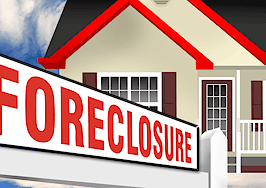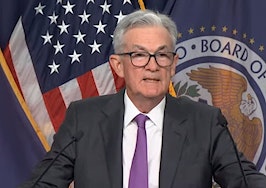No one can predict the future of real estate, but you can prepare. Find out what to prepare for and pick up the tools you’ll need at Virtual Inman Connect online Nov. 1-2, 2023. And don’t miss Inman Connect New York on Jan. 23-25, 2024, where AI, capital and more will be center stage. Bet big on the future and join us at Connect.
The past three years could’ve been different.
That was the gut-punch Goldman Sachs Investment Strategy Group VP Michael Murdoch delivered at BuiltHOW, Ben Kinney Companies’ annual three-day business training and coaching conference in Phoenix.
“Everything was just kind of muddling along. Then we had the pandemic, which was a huge shock to the system. This was something like a natural disaster. So this is not a normal economic cycle,” he told the audience while perched next to Kinney and PLACE Chief Real Estate Officer Brian Gubernick. “Effectively we turned off the car, right? We shut it off because we’re trying to protect people. That meant that gross domestic product collapsed [and] unemployment spiked. We then responded by having a tremendous amount of monetary and fiscal stimulus.”
“We’re going down the highway 100 miles an hour, and [The Federal Reserve] absolutely slammed on the brakes,” he added in reference to the series of record interest rate hikes over the past 18 months. “It’s easy for us to be armchair quarterbacks after the fact. But it’s pretty clear we should’ve done something different — downshift from 80 to 60 to 40. That kind of slowdown is much better than what we effectively did.”
Murdoch said the government overplayed its response to inflation, with Congress passing “one or two too many” fiscal packages and the Federal Reserve waiting too long to begin raising interest rates and slow their purchase of securities assets. The government’s botched timing has put the housing market into a serious bind, as it becomes nearly impossible for would-be homesellers to enter a market with higher rates and home prices.
“For the people in this room, the most important number in the world right now is four,” he said. “Four percentage points is what the effective interest rate is on the stock of outstanding mortgages in the United States. [. . .] That gap has widened so much now that if you’re sitting on a mortgage, it’s really hard to feel like you want to let go of something that’s below 3 percent.”
The astronomical rise of interest rates has locked down the real estate market, as skittish homesellers tank existing-home inventory and sales and homebuilders struggle to fill in the gap for hungry homebuyers. Murdoch said the building market has been behind the 8-ball ever since the Great Recession, and early pandemic supply chain issues threw another wrench into the plan.
“We never really recovered from a global financial crisis in terms of housing inventory,” he said. “We’ve talked about this in the past. We never really replenished that stock, and then because of supply chain issues, getting garage doors and whatever labor and raw materials, we actually didn’t have a good pipeline of new construction.”
The Goldman Sachs VP said the new-home market is beginning to recover from its pandemic woes and feed more inventory into the market; however, American homeowners’ solid wages, resilient home equity and strong personal finance balance sheets allow them to weather the storm in place rather than enter an uncertain landscape.
“The U.S. economy has been incredibly resilient in large part because of this, because 70 percent of the debt that households hold is in their mortgages, right?” he said. “So even if interest rates are spiking, people aren’t moving. They’re still able to weather that.”
Murdoch said he hopes to see moderating interest rates this year, even as sticky inflation stokes fears about another rate hike in November. He said rate moderation depends on the Fed’s ability to effectively control short-term and long-term interest rates — while avoiding a major recession.
“There’s the 10-year treasury yield, which people call the risk-free rate because you can just buy it from the government. That’s running at about 4.3 percent,” he said. “Whatever that difference is between 4.3 and where market rates are today, that spread is also super wide. The interest rate that the Treasury pays is not likely to decline a whole lot from here unless you get a recession. The Fed is still going to have to keep interest rates pretty high,”
“The people who buy those mortgages on the top, they’re saying, ‘Why am I going to buy these mortgages when there’s so much risk [and] I can find similar exposures elsewhere in the fixed income universe?’ That’s why that spread widens,” he added. “The Federal Reserve, who used to be the largest purchaser of those mortgages, is actually passively letting those roll off their balance sheet.”
Although a sizeable drop in short-term rates isn’t in the cards, Murdoch said the Fed has the ability to slim the rate spread by increasing its balance sheet and buying securities.
“They can also use their balance sheet, and this is getting into quantitative easing,” he said. “They’re adding to their balance sheet by going out and buying securities from financial intermediaries like banks, and they’re adding that to their balance sheet. It’s an asset and a liability. They’re increasing both of those sides. It’s not just creating money out of thin air.”
“This is them taking securities off of banks balance sheets, and they’re increasing reserves to incentivize those banks to lend more and push everybody higher up the risk spectrum — to get people to invest more and to get banks to lend more,” he added. “This is another way they can do that instead of just focusing on that short-term interest rate. [This strategy] puts downward pressure on longer-term interest rates and that pushes 10-year treasury yields down and that pushes mortgage rates down.”
Murdoch said there’s a 50-50 chance that another hike will happen in November, but stabilizing goods, housing and services costs give him hope the Fed will skip pushing short-term rates up again. “[Home prices] had declined for a while and they’re starting to pick back up or float along,” he said. “That’s looking like it’s headed in the right direction over the next couple of quarters before it stabilizes. So housing is headed in the right direction.”
Murdoch, Kinney and Gubernick said they expect rates to come down by mid-to-late 2024, assuming the U.S. is able to avoid a recession. By 2026 or 2027, they expect rates will drop closer to 3 percent, which doesn’t offer any help to consumers who need to buy or sell now.
“Over time, interest rates should start to work their way back down to five and a half percent something closer to 3 percent over the next couple of years,” Murdoch said. “That’s a long time. And in the meantime, that means, obviously, volumes are likely to still be pretty impaired despite people’s balance sheets being really, really healthy in the U.S.”
Although the fog has yet to lift, Murdoch said robust household formation rates and the enduring importance of homeownership will keep the housing market trucking along as the economy works its way out of a pandemic-induced slump.
“There’s obviously going to always be a market for people who are forming new households, and that’s running at multi-decade highs,” he said. “Household formation is running very, very hot. People are getting married and thinking about children. People are always going to be moving for some one reason or another.”
“And over time, as we start to see a little bit of convergence [with long-term interest rates] you’re gonna see activity start to pick up.”













